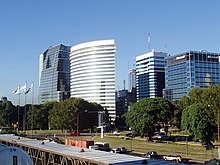
Back Буенос-Аирес Abkhazian Buenos Aires ACE Буэнос Айрес ADY Buenos Aires Afrikaans Buenos Aires ALS ብዌኖስ አይሬስ Amharic Buenos Aires AN Buenos Aires ANG بوينس آيرس Arabic بوينوس آيريس ARY
Autonomous City of Buenos Aires | |
|---|---|
| Ciudad Autónoma de Buenos Aires Buenos Aires Ciudad | |
|
| |
| Nicknames: | |
 Location in Argentina | |
| Coordinates: 34°36′12″S 58°22′54″W / 34.60333°S 58.38167°W | |
| Country | Argentina |
| Established | 1536, 1580 |
| Government | |
| • Type | Autonomous city |
| • Chief of Government | Jorge Macri |
| Area | |
| • Autonomous City | 203 km2 (78.5 sq mi) |
| • Land | 203 km2 (78.5 sq mi) |
| • Metro | 4,758 km2 (1,837 sq mi) |
| Elevation | 25 m (82 ft) |
| Population (2010 census.)[3] | |
| • Autonomous City | 2,890,151 |
| • Rank | 4th |
| • Density | 14,000/km2 (37,000/sq mi) |
| • Metro | 12,801,364 |
| Demonym(s) | porteño (m), porteña (f) |
| Time zone | UTC−3 (ART) |
| Area code | 011 |
| HDI (2010) | 0.953 – Very High[4][not in the source given] |
| Website | www |

Buenos Aires is the capital and largest city in the South American country of Argentina. It has its own executive, legislative and judicial powers. It is in the central-eastern region of the country, on the southern shore of the Río de la Plata, in the Pampas region. The city was ceded in 1880 by the Province of Buenos Aires to be the federal capital of the country. It is the "main capital", along with 24 alternate capitals, because of the constitutional reform of 1994. Buenos Aires city is also known as Capital Federal to differentiate the city from the Buenos Aires Province. Until 1994 Buenos Aires city was under the presidential government, but after a constitutional reform in that year, the city became self-governed, allowing citizens to elect their city authorities.
- ↑ Owens, Mitchell. "Travel+Leisure: Buenos Aires Reinventing Itself". Travelandleisure.com. Retrieved 2 May 2012.
- ↑ "Sitio oficial de turismo de la Ciudad de Buenos Aires". Bue.gov.ar. Archived from the original on 15 April 2012. Retrieved 2 May 2012.
- ↑ "Argentina: Censo2010". Archived from the original on 20 December 2010. Retrieved 25 February 2011.
- ↑ "Reports | National Reports | Latin America and the Caribbean | Argentina | Human Development Reports (HDR) | United Nations Development Programme (UNDP)". Hdr.undp.org. Archived from the original on 2013-04-26. Retrieved 2013-03-12.










